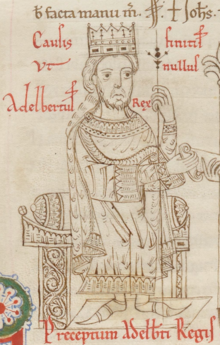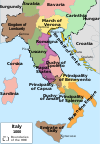
Adelaide of Italy, also called Adelaide of Burgundy, was Holy Roman Empress by marriage to Emperor Otto the Great. She was crowned with him by Pope John XII in Rome on 2 February 962. She was the first empress designated consors regni, denoting a "co-bearer of royalty" who shared power with her husband. She was essential as a model for future consorts regarding both status and political influence. She was regent of the Holy Roman Empire as the guardian of her grandson in 991–995.
The 950s decade ran from January 1, 950, to December 31, 959.

Year 956 (CMLVI) was a leap year starting on Tuesday of the Julian calendar.
Otto-William was count of Mâcon, Nevers, and Burgundy.
Rudolph II, a member of the Elder House of Welf, was King of Burgundy from 912 until his death. He initially succeeded in Upper Burgundy and also ruled as King of Italy from 922 to 926. In 933 Rudolph acquired the Kingdom of Lower Burgundy (Provence) from King Hugh of Italy in exchange for the waiver of his claims to the Italian crown, thereby establishing the united Kingdom of Burgundy.

Berengar II was the King of Italy from 950 until his deposition in 961. He was a scion of the Anscarid and Unruoching dynasties, and was named after his maternal grandfather, Berengar I. He succeeded his father as Margrave of Ivrea around 923, and after 940 led the aristocratic opposition to kings Hugh and Lothair II. In 950 he succeeded the latter and had his son, Adalbert crowned as his co-ruler. In 952 he recognised the suzerainty of Otto I of Germany, but he later joined a revolt against him. In 960 he invaded the Papal States, and the next year his kingdom was conquered by Otto. Berengar remained at large until his surrender in 964. He died imprisoned in Germany two years later.
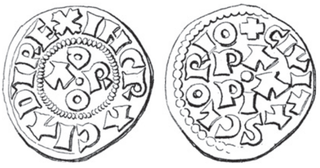
Arduin was an Italian nobleman who was King of Italy from 1002 until 1014.
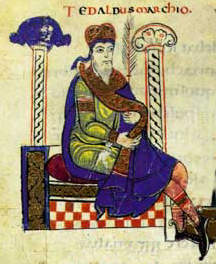
Tedald, of the House of Canossa, was the count of Brescia from 980, Modena, Ferrara, and Reggio from 981, and Mantua from 1006. He used the title of margrave because of his vast comital holdings and their frontier nature. His family's seat was Canossa and he was the son of Adalbert Azzo of Canossa who had supported Otto I against Berengar of Ivrea and Adalbert of Ivrea. His rise was largely due to his loyalty to the Ottonian Dynasty.
Hubert was the illegitimate son of King Hugh of Italy and his concubine Wandelmoda. He became Margrave of Tuscany in 936 and Duke of Spoleto and Margrave of Camerino in 943.
Guy was the margrave of Ivrea from 950 to his death. In 950, his father, King Berengar II of Italy, appointed him to rule in the familial margraviate. His mother was Willa of Tuscany, his elder brother was Adalbert II, co-king with their father, and their younger brother was Conrad.
The March of Ivrea was a large frontier county (march) in the northwest of the medieval Italian kingdom from the late 9th to the early 11th century. Its capital was Ivrea in present-day Piedmont, and it was held by a Burgundian family of margraves called the Anscarids. The march was the primary frontier between Italy and Upper Burgundy and served as a defense against any interference from that state.

The Anscarids or the House of Ivrea were a medieval dynasty of Frankish origin which rose to prominence in Northern Italy in the tenth century, even briefly holding the Italian throne. The main branch ruled the County of Burgundy from the eleventh to fourteenth centuries and it was one of their members who first declared himself a count palatine. The cadet Castilian branch of Ivrea ruled the Kingdom of Galicia from 1111 and the Kingdoms of Castile and León from 1126 until 1369. The House of Trastámara, which ruled in Castile, Aragon, Naples, and Navarre at various points between the late 14th and early 16th centuries, was an illegitimate cadet branch of that family.
Willa, known as Willa of Tuscany (911/912–970), was a medieval noblewoman. By birth, she was a member of the Bosonid noble dynasty. By marriage to Berengar II of Italy she was Countess of Ivrea from 930 to 963, and queen consort of Italy from 950 to 963.
Arduin Glaber was count of Auriate from c. 935, count of Turin from c. 941/942, and Margrave of Turin from c. 950/964. He placed his dynasty, the Arduinici, on a firm foundation and established the march of Turin through conquests and royal concessions. The Chronicon Novaliciense, the chronicle of the abbey of Novalesa, is the primary source for his life.
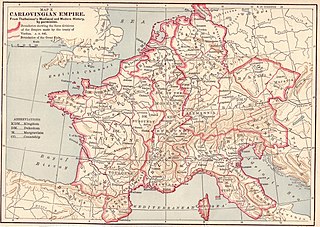
The March of Friuli was a Carolingian frontier march, established in 776 as the continuation of the Lombard Duchy of Friuli, established against the Slavs and Avars. It was ceded to the Duchy of Bavaria as the March of Verona in 952. Its territory comprised parts of modern-day Italy, Slovenia and Croatia.
The Arduinici were a noble Frankish family that immigrated to Italy in the early tenth century, possibly from Neustria. They were descended from and take their name after one Arduin (Hardouin).

Otto I, traditionally known as Otto the Great, or Otto of Saxony, was East Frankish king from 936 and Holy Roman Emperor from 962 until his death in 973. He was the eldest son of Henry the Fowler and Matilda of Ringelheim.
Gerberga, Otto-William's mother, was, by her successive marriages, queen of Italy, margravine of Ivrea (965–970), and duchess of Burgundy (971/5–986/91).
Willa of Spoleto was the daughter of Boniface I, duke of Spoleto. Through marriage to Hubert, Duke of Spoleto Willa became duchess of Spoleto and margravine of Tuscany.
